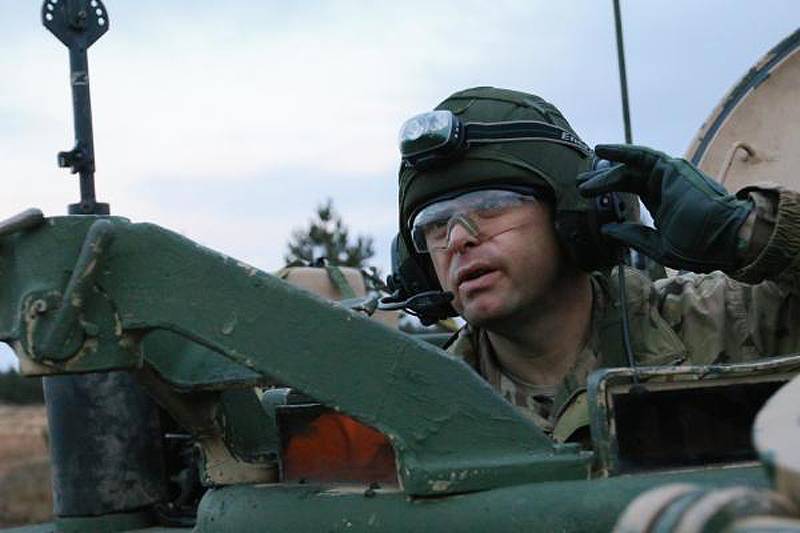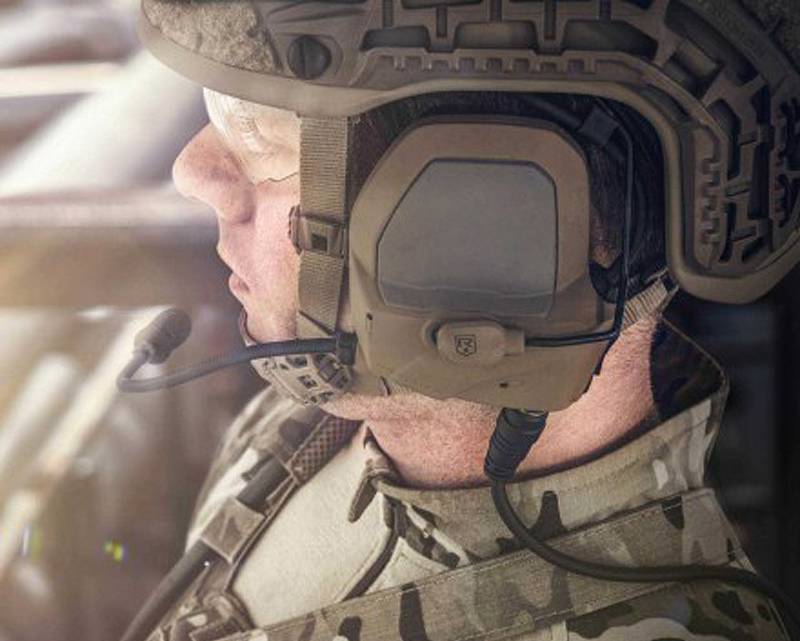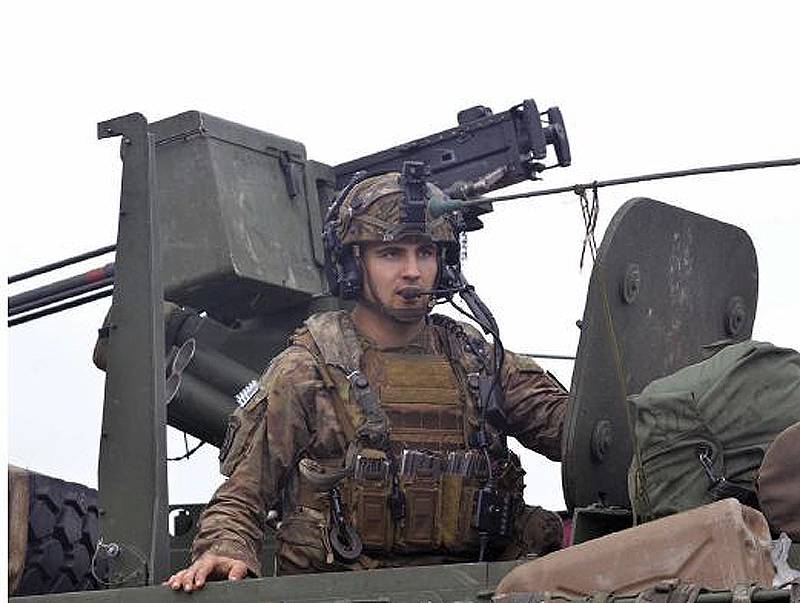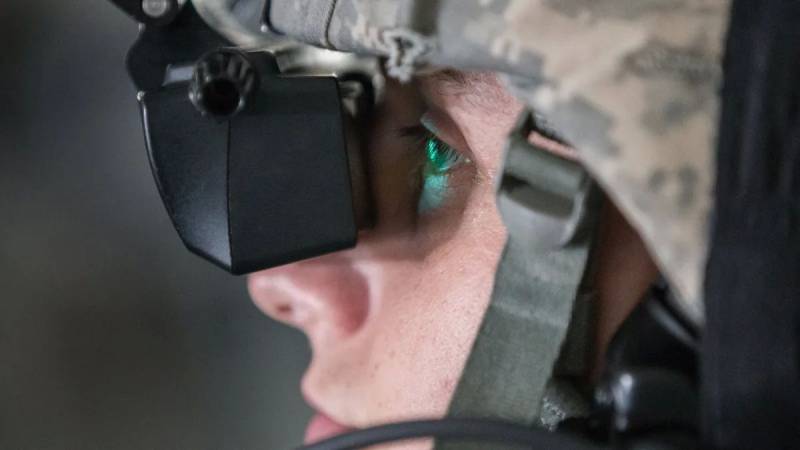Hear and understand. Development of tactical communication headsets

A US Army soldier receives information on the headset on the movements of its soldiers during combat training in Latvia
Headphones must also be compatible with other equipment, such as helmets, work in difficult conditions (heat, cold, humidity and dust) and integrate with various platform communication systems.
Old and new
Such a large number of requirements makes it difficult to manufacture tactical headsets that would fully meet the needs of the soldiers and would not be a burdensome part of the equipment. The market for such equipment can be divided between traditional headphone variants and newer intra-channel (intra-ear) devices.
All existing telephone headphones consist of three main components: two telephones with a cup and a ear cushion, connected by a jumper that goes around the head, which allow you to hear unwanted sounds being transmitted and delayed outside; microphone with filter for delaying too loud noise: and the cable connecting the headset to the radio or other audio device.
In the in-ear devices, a small insert is used, which is inserted into the ear like a commercial headset. However, the composition of such a headset also includes a microphone connected by a cable to a radio station on the chest.
Matthew Chemenez from Silynx, a developer and manufacturer of headsets, said that headset headsets still dominate the market. Although still these devices continue to be technically improved, for example, due to advanced noise filter filters, it is difficult to make the incoming sound much cleaner than it already is.
In his opinion, “major changes” occur at the application level, while the soldiers see the advantages of intra-ear devices compared to earphones. He also believes that headset "should be considered today as unacceptable devices."
His argument is that the ballistic helmets offered today to soldiers with highly trimmed cords are specially “sharpened” for the use of headsets, since it is necessary to provide space for telephones. Chemenez noted that the military, together with the industry, decided to exclude 25% protection, which the standard ballistic helmet provides so that you can use headphones, this is "hardly a compromise solution." The argument put forward by him. is that headsets must be designed for the main platform, i.e. a helmet, and that changes in the design of the helmet to match the headset are “partial optimization”.
Agree to disagree?
Manufacturers of existing headsets with such arguments strongly disagree. According to Erik Fallon of 3M Peltor, intra-aural solutions can only be worn for short periods of time, after which they become uncomfortable and, “if you pull it out, it’s already difficult to put it back in, unlike headphones.”
He said that the experience of using headphone products is much richer and that the special forces of the US Navy and the Delta squad “love them for the most part”. Although he acknowledged that some commanders "without experience" believe that the intra-aerial systems are a promising way, he sees the only possible use of them in cases when a very large secrecy is needed and the soldiers should be hardly noticeable.
Chris Moore of Revision Military, which launched the new Sensys ComCentr2017 headset in 2, said that the in-ear devices are a relatively new piece of equipment. The United States Marine Corps (ILC) received these devices with a macro-deep supply liner only in 2009; more than 40 thousand units purchased were never deployed in units.
According to Chemenez, progress in the field of in-the-ear products makes them more reliable. He said that Silynx does not use bone conduction technology for its microphones. This approach has been used for some time for in-the-ear headsets, but it requires accurate placement of the liner in a special part of the ear where there is a cartilaginous protrusion so that voice vibrations can be transmitted.
He noted that they could become a problem for the soldiers, because in the case of a displacement or removal of the liner from this zone, the connection ceases. As an alternative to bone conduction, Silynx uses a microphone in the insert. This means that the headset can be moved without breaking the connection, and this solution allows you to hear whispers much more clearly, which is not the case with bone conduction devices that have problems with it.
Chemenez’s critical comments on headset headsets are as follows: they add 0,5 kg to the weight of the helmet; in hot weather with closed ears it is very uncomfortable; and they are attached to the helmet and, if removed, the soldier is left without communication. He added that if a soldier uses eye protection or goggles, then the arms behind the ears can break the tightness of the liner and quickly deteriorate the protection against noise.

The ComCentr2 headset is intuitively controlled using a simple handheld device.
Consequently, the task of companies such as Silynx is to provide compelling arguments in favor of using in-the-ear sets, but so far the military’s response to this has been mixed. Chemenez believes that this is due to the preferences of different generations. Older soldiers who traditionally used headsets tend to prefer these devices and therefore are unlikely to choose a new piece of equipment that they consider uncomfortable.
He referred to the program of the American Army 2013 of the year, according to which a small number of in-the-ear devices were purchased for testing, with the prospect of increasing the volume of purchases for all infantry units. However, Chemenez remarked that, in fact, the program was rather “experimental” and was abandoned after three months.
He compared this reaction with the reaction of law enforcement agencies, which have no problems with intra-aural systems, since the police and other structures do not have similar experience with the use of headsets and therefore do not consider intra-ear analogs uncomfortable. “The point is perception. Headsets and headsets are also uncomfortable, but this is a different type of discomfort. ”
Moore agreed that perception is important and “progressive people do a better job using in-the-ear devices, and people who really dislike change do not even want to hear about it.” According to him, because of differences of opinion, the military are trying to try both options so that the personnel could choose. ”
The case was moved from place with the release of two requests for information on hearing aids. The first for Communications Accessory Suite-Land was released by the army in June 2017 of the year, and the second for Hearing Enhancement Devices was released by the USCM in September of 2018.
In order to best meet the needs of these requests are provided earbud and intra-ear options. It can be said that the worldview is slowly beginning to change and more and more military people are recognizing the possibilities that intra-devices provide. However, whether these products will be purchased in large quantities for the army and marines as part of the official program is not entirely clear.
Be the first
While regular armies are rather reluctant to take on the mind-to-arm solutions, special operations forces have been using these devices for quite some time. Although the 3M Peltor Comtac III headset family is undoubtedly one of the most popular solutions and used by special forces in many countries, in-the-ear options have recently become increasingly popular.
Chemenez reported that Australian, British and American MTRs are leaders here and that the British have been using Silynx products for more than ten years. “These special forces have completely changed their worldview, which cannot be said of other countries.”
Fallon noted that headsets can be used in virtually any environment, in all environments, from air and water to desert and dust; they are reliable enough for most operations. This attracts special forces, since such devices can be used, for example: to exchange messages with the crew of the aircraft, during parachute jumps, when swimming in water (depth to 20 meters), on beaches and other sandy terrain.
He added that the earphone options include attaching phones to the guide on the helmet with the trimmed crown so as not to throw the jumper around the head. This allows, if necessary, to move them for ventilation of the parotid space.
However, as is the case with Silynx’s in-the-ear products, 3M also had problems with testing its headphone products and therefore refused them. Fallon noted that it all came down to the helmet problem; Some soldiers wore helmets of the wrong size when using the headset, explaining this as discomfort.
“The US military has gone a certain way to understand how important a helmet is for a soldier, especially if you add devices to this helmet,” Fallon remarked. “Ordinary units will not give up on high-hinged helmets in the near future, since the emphasis is on anti-bullet protection.”

A soldier talking on a headset while sitting in an M1126 Stryker armored vehicle.
Protection issue
However, due to the fact that conventional armed forces are becoming more technically advanced, the priority of communications also increases.
Fallon also called hearing protection one of the key tasks, adding that the Department of Veterans Affairs spent half a billion dollars on hearing problems with former military personnel. The hearing protection system in headsets must cope with the transition from very quiet scenarios to extremely loud ones, as well as sudden events that soldiers face in combat conditions.
For example, a patrol office in Afghanistan can spend several days in a very quiet environment, in which case there is no need for hearing protection. However, during a clash it becomes very noisy, especially when using such weapons, such as the AT4 hand grenade launcher, whose loudness of the shot reaches 180 dB, "while it can negatively affect the hearing organs, sometimes until the end of life." Fallon added that you need to understand "audio needs, because they are complex and should include periods of silence."
However, different types of noise affect differently, and the noise of an explosion does not have the most negative effect on hearing. The steady-state long-term noise created by machines, airplanes, engines, and generators has a much greater negative impact due to its constancy and duration.
As Fallon explained, a peak pressure is created during shooting that lasts less than a second. Constant noise can damage hearing organs already at a volume of more than 85 dB; for example, the noise from an armored car HMMWV may be at the level of 100 dB, and the helicopter CH-47 Chinook at the level of 125 dB. This is more harmful than an 140 dB blast, a M4 rifle shot, 164 dB volume, or even an AT4 grenade launcher.
Tactical headsets provide hearing protection in two ways. The first method is electric, the microphones in the headset receive and amplify the noise for the user. This limits any sound to louder than 82 dB. The second type is passive protection using ear cushions around the ear for the headset and earbud for the in-ear headset. Fallon noted that the in-ear devices can provide better passive protection with higher noise absorption, but the earphone devices still meet all requirements.
Moore said that the military command wants to go to the in-ear headsets because of the best single-level attenuation (one set of ear inserts).
European Hearing Protection Act EAR352 determines the characteristics of the earmolds from constant noise at low, medium and high frequencies. "Ear plugs show better results in tests than headsets, but big problems arise when they are used for a long time." After four hours of wearing, the ears begin to ache, while the earphone devices can be worn for a long time.
US National Guard serviceman looks into the display of a headset of a virtual reality simulator Dismounted Soldier Training System
Time for technology
However, looking at the prospect, Moore said that there is still room for the development of headsets. He noted that devices such as the Comtac from the 3M Peltor and the like are analog, and while they are “doing their job,” there is time to create new advanced devices.
“Over the past 10 years, the in-ear market has brought a lot of technology to the headset industry,” he said. This is of course digital electronics, which is necessary in the production of intra-aural systems. At the same time, Moore noted that she had never been introduced into the market of earphone systems, and this is exactly where Revision sees the flaw in its ComCentr2 headset.
As for hearing protection, Revision has included a quick noise cancellation system in its headset when a reverse wave is generated for audible noise with the goal of active partial damping. “We were able to integrate this system into a headset, which gives a huge advantage in the low-frequency spectrum,” said Moore. “We obtained certain results in the laboratory and can offer noise reduction in decibels by half for a low-frequency passive headset, and this is a very good indicator, since decibels are a logarithmic quantity.”
Revision also uses a digital signal processor in the headset, which uses noise reduction algorithms. This allows you to act in a wider range of noise conditions than if the signal transmission went directly to the radio station via a standard cable.
There are also advantages with regard to increasing the level of possession. "What digital electronics will allow us to do is significantly reduce the size of the microcircuits and significantly improve the fidelity with a larger number of microphones."
Instead of just two forward-facing microphones that record noise and play it on the speakers, there are two more microphones aimed backwards. With digital processing and appropriate filters, this allows the user to distinguish between front and rear noises.
Moore said that the front-to-rear error level in the in-ear and earphone devices — especially in the latter, since they are further away from the ear — can be up to 40%, since the sounds coming from the front and back are mixed. "You think something is in front of you, but it is behind you."
“In no way can you have this front-to-front error on the battlefield, as it is very confusing and confusing to the user. That is why we introduced rear microphones in order to bring this front-rear information to the user. ” That is why, in his opinion, it is necessary to achieve proper 3-sound situational awareness, although most competitors will have two front microphones, and some just one.
Expansion of the three-dimensional audio capabilities is to create a spatial separation; this is exactly what Revision is positioning as an advantage that distinguishes its products from those of other manufacturers. This feature allows the user to listen to several conversations at the same time, and then switch to the more important one — in the same way, ears can selectively block some conversations being held nearby, and better understand others.
“Future commanders will have up to four radio networks connected simultaneously. The JTACS system has four networks that operate simultaneously, with different names, different equipment and people, but the current systems allow, at best, only two networks in one ear and two networks in the other. - explained Moore. - In the worst case, you must have a different pair of headsets for each network; in order to receive and transmit, it is necessary to switch between them. ”
Revision offers to take these streams of information and process them with a surround sound algorithm, known as the Head Related Transform Function, which divides them into two channels (left and right ear), but then deceives the user, making him think that the sound comes from the space around him . It seems that the sound of each of the four networks comes from four different directions, 90 ° to the right, 90 ° to the left, 45 ° to the left in front and 45 ° to the right from the front.
“There are two main effects,” explained Moore. “First, your brain can instantly understand where the conversation and the sound of the radio network are coming from, secondly, the sound is transmitted to both ears, which makes it louder and more intelligible.”

The ATGM operator on the base of the M1134 armored vehicle is checking its headset before being sent to the shooting range.
Put down
Another technological advantage is the elimination of wire headsets, since in this case the user can move his head more freely. Cables are the main cause of complaints of soldiers, regardless of the type of tactical device.
The solution is wireless, excluding cables, but Chemenez remarked that this could create a new problem — separate charging of the headset. In the field, this can be a problem with a shortage of power sources.
Moore noted that wireless communication tools of the dongle type are available (any device whose connector is mounted directly on its case), which allows you to connect these devices directly to a headset or radio station to establish a wireless connection. In this case, it does not require a lot of energy or a large antenna to establish communication.
Some promising technologies include near-field magnetic induction (NFMI) magnetic field induction. According to Moore, the advantage for the military is that "the probability of detecting or intercepting a signal on 10-20 meters is much lower than that of systems based on electricity, for example, a Bluetooth signal or a standard VHF radio."
Fallon said that NFMI creates a small magnetic field within a radius of two meters from the source, increasing safety and reliability of operation, and that wireless technology is very promising, although it is necessary to increase its reliability and secure it by encryption.
Tactical headsets are able to offer more opportunities than ever before: improved hearing protection; operation in more severe external conditions; and advanced connectivity options. Special operations forces traditionally lead in this area, but, looking at the continuous process of miniaturization and digitization, it is easy to guess that an increasing number of countries will accept such devices to supply their regular forces.
At present, the military must, firstly, decide what they really need, and, secondly, make sure that the soldiers are using and testing the systems correctly, otherwise the chance to gain qualitatively new advantages on the battlefield may not turn up for them.
On the materials of the sites:
www.nationaldefensemagazine.org
www.silynxcom.com
peltorcomms.3m.com
www.revisionmilitary.com
www.dvidshub.net
www.alamy.com
en.wikipedia.org
pinterest.com
en.wikipedia.org

Information